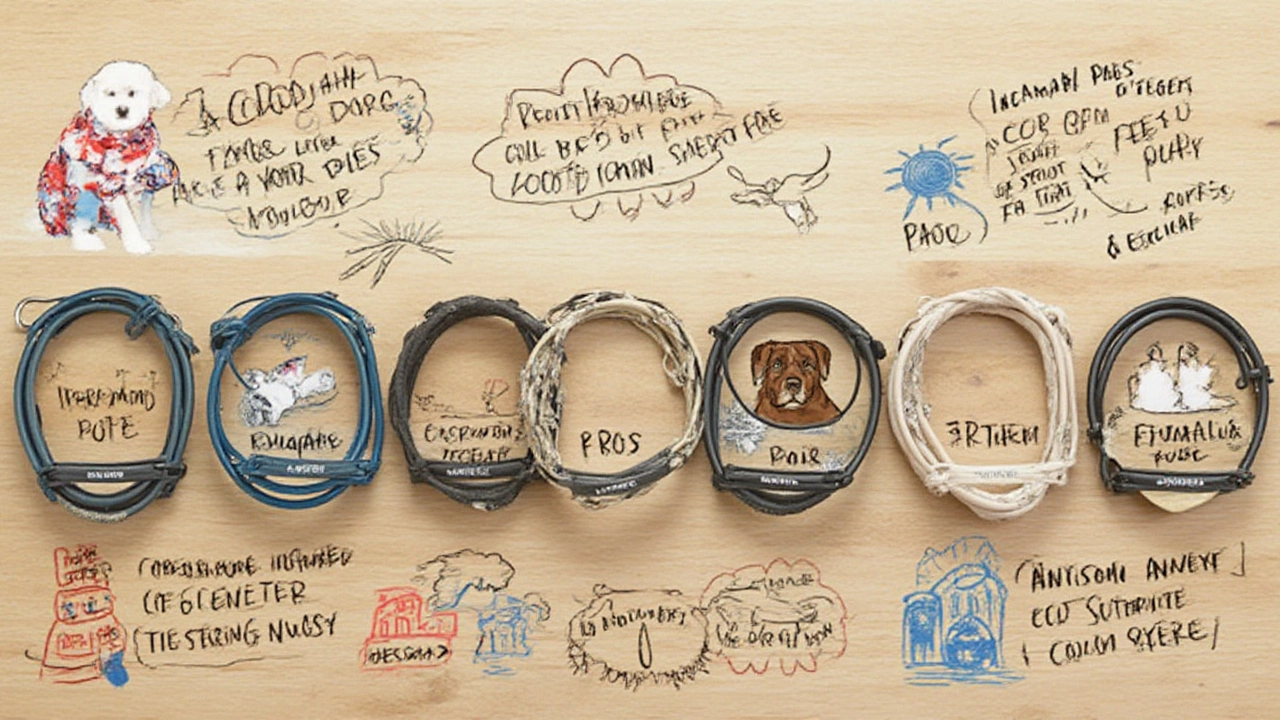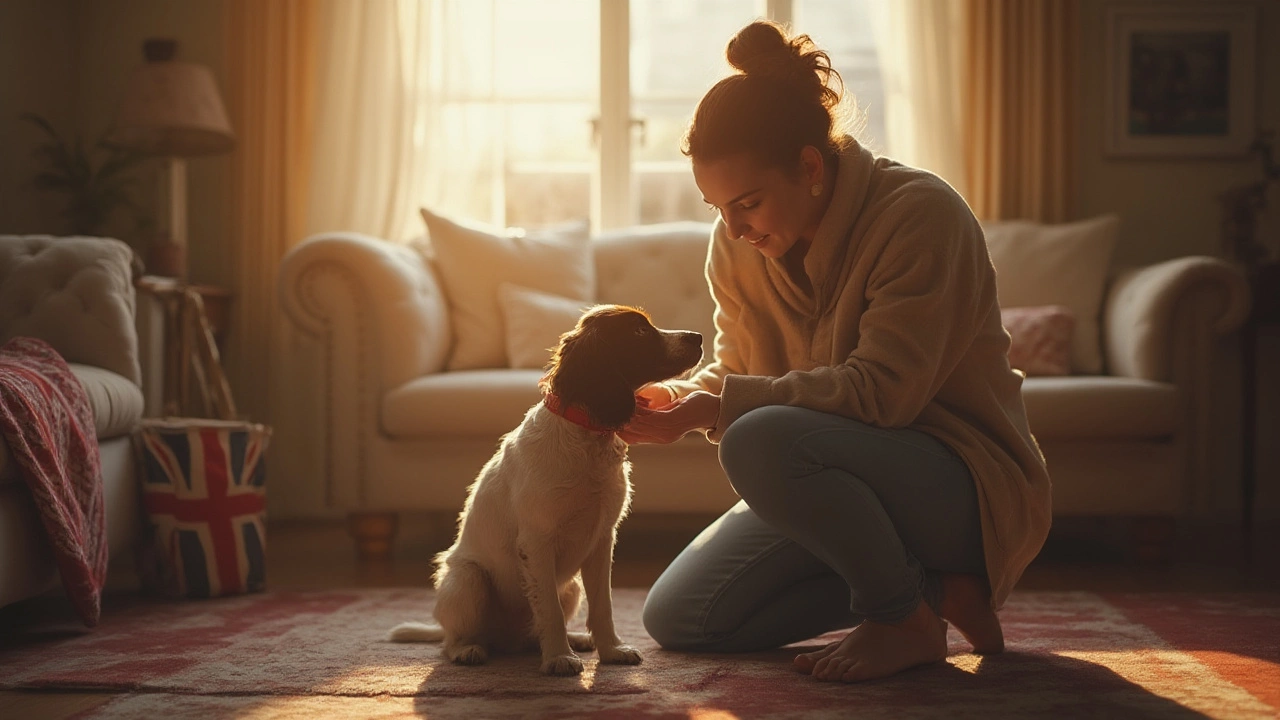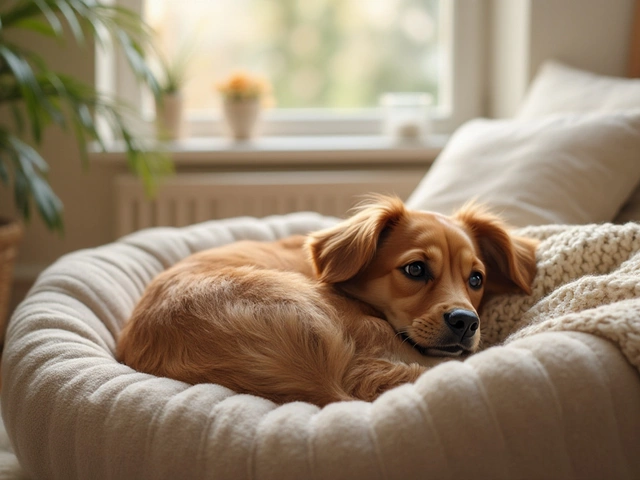Imagine coming home to a frazzled pup with big, anxious eyes, tail between the legs, and a stubborn refusal to chill out long enough to sleep. Maybe your neighbor recommends a dog calming collar—a seemingly magical fix promising calm in a snap. Is it just hype, placebo, or real science? Dog owners everywhere are hotly debating whether these collars actually do anything for stressed-out pets or just make us feel like we're taking action. The stakes feel high when your four-legged friend is panicking about fireworks, thunderstorms, or just the mailman doing his daily rounds. So what's the actual deal with calming collars?
What Exactly Are Dog Calming Collars?
If you cruise a pet aisle, you'll find calming collars in different colors, sizes, and brands. But crack open the package and you'll notice these things don't look much different from a regular flea collar. The secret is in what you can't see. Most calming collars for dogs rely on synthetic pheromones—the chemical signals that mama dogs naturally give off to calm their puppies. Think of it as invisible comfort: these pheromones don't smell to humans but supposedly work like a security blanket for your pet.
Some collars go beyond pheromones and add essential oils like lavender or chamomile, which have a reputation for relaxing both humans and animals. Others throw in plant-based materials that are supposed to encourage feelings of safety. Each brand touts a proprietary blend, but the basic pitch stays the same: slip a collar around your dog's neck and, within an hour or so, anxiety melts away.
This all sounds lovely on paper, but is there real science backing it up? Here's where the story gets interesting. The most famous example is the Adaptil collar (formerly called D.A.P., or Dog Appeasing Pheromone). In the mid-2000s, a handful of studies—yes, actual peer-reviewed research—suggested that dogs exposed to Adaptil were less anxious during things like travel, visits to the vet, or thunderstorms. These studies usually measured symptoms like pacing, barking, and hiding. In some cases, owners reported fewer stress signals when their dog wore the collar versus a placebo.
But here's the catch: while some results looked promising, other studies found the effect was small or inconsistent. Scientific reviews published since 2018 have called out a lack of large, independent trials showing major improvements. Pheromone collars aren't a magic bullet, but they're not total snake oil either. You might be in for a pleasant surprise—or practically no difference at all.
How Do Calming Collars Actually Work?
Okay, so these collars bathe your dog in pheromones, but how does that actually make a difference? To get a little nerdy for a second: dogs have something called a vomeronasal organ (sometimes called Jacobson's organ) inside their nose. It's kind of like a built-in chemical detector—noticeably more tuned in than anything humans have. When the collar emits pheromones, your dog picks them up, and this signal travels straight to the part of their brain that handles emotions and stress. It's almost like flipping on a "relax mode."
In theory, this should work even if the collar isn't super close to your dog's nose. The pheromones are released slowly, creating a kind of low-level background signal, not a fast burst. Most collars are designed to last anywhere from a month to three months, and you typically don't have to worry about taking them off at night or during baths (though with essential oil collars, double check the fine print—some break down with water exposure).
But let's pause for a reality check: not all dogs react the same way. Some will mellow out like they're at a doggy spa, while others seem totally unaffected. Age, breed, personality, and even how the collar was introduced can play a role. Pheromone sensitivity is just as personal for dogs as fragrance preferences are for people. A 60-pound golden retriever who loves everyone might shrug off a new scent, while an anxious rescue mutt could find huge relief—or nothing at all.
Essential oil-based collars introduce another wrinkle. While lavender and chamomile do seem to have some relaxing effects in studies involving both animals and people, dogs have much stronger sniffers than we do. Sometimes strong scents can even become overwhelming or unpleasant. If you ever see your pup pawing at the collar, sneezing, or acting uncomfortable, that's a sign the blend is too strong—or just not for them.

When Do Dog Calming Collars Help—and When Might They Fail?
This is the big question. Calming collars get the most buzz before fireworks, thunderstorms, travel, or big changes. They're often used for separation anxiety, crate training, visits to the vet, or even welcoming new pets or babies into the house. A 2019 study from the Journal of Veterinary Behavior found that pheromone collars were most effective for mild to moderate anxiety—not the kind where your dog tears up the house or seems panicked 24/7. If your pup's stress is more situational, like getting nervous before car rides or new people, a collar could gently take the edge off.
Think of calming collars as one tool in a bigger toolbox. They can work best when you pair them with behavior training, positive reinforcement, or other anxiety aids recommended by your vet. Some trainers use them in combination with "desensitization" exercises, gradually exposing a dog to the trigger while they're feeling calm. That way, the collar gives them a steady baseline of comfort while you build their confidence bit by bit.
- Fireworks and thunder don't freak out your dog as much, and barking drops down a notch—but they may still react to scary noises.
- Nervous car rides sometimes get easier, but motion sickness isn't fixed by pheromones.
- Dogs with deep separation anxiety may need more intensive help: prescription meds, dedicated training, or special routines for alone time.
If you expect a total personality makeover, you'll probably be let down. Some dogs just act like themselves, collar or not. (I have a friend whose beagle wore three collars at once and still spent Fourth of July under the bed.)
Vet advice is a game-changer here. If your dog is destroying the house or hurting themselves, don't stop at the pet store aisle. There are cases where medication, advanced training, or medical workups are needed. See the collar as a gentle nudge, not a total fix.
Tips for Using Dog Calming Collars—and Other Calming Hacks
Picking the right collar takes a little trial and error. Start by reading reviews from owners with similar dog breeds and ages, since what works for a nervous Chihuahua might not help a sturdy lab. Look for reputable brands that actually share their research (Adaptil, Sentry, Comfort Zone). Skip anything with sketchy ingredients or mystery oils—dogs are family, and you want them safe.
After you choose a collar, follow these basic tips for best results:
- Put the collar on a day or two before any big event, not just right before the stressor hits. This gives it time to kick in.
- Keep the collar snug, but not tight—you should be able to fit two fingers under it easily.
- Don't pile multiple collars on your dog; just use one at a time. Layering doesn't multiply the effect.
- Check your dog's skin for irritation, especially if they have allergies or sensitive skin. Sometimes the collar material or oils can cause redness or itchiness.
- Monitor your dog's behavior for subtle changes, like less hiding or pacing. Not every transformation is dramatic; sometimes the improvement is quieter.
- Pair the collar with calm music, puzzle feeders, or a cozy spot away from noise, especially if your dog deals with major triggers like fireworks.
- Bring it up during your next vet visit, especially if you notice improvements or have concerns about side effects.
A helpful touch: snap a "before and after" video to really see if your dog is less stressed with a collar on. It's easy to miss gradual changes in the day-to-day chaos.
What about homemade calming collars? These do pop up online, usually involving bits of fabric and drops of essential oils. Use caution: not all oils are safe for pets (tea tree oil is toxic), and too strong a scent can make things worse. Commercial collars are designed to release ingredients slowly, which is tricky to do with a DIY project.
If the collar alone isn't quite enough, consider layering with these tried-and-true calming strategies:
- White noise machines to muffle storm or firework sounds.
- Weighted blankets (yes, they make dog versions now) to mimic hugging pressure.
- Food-dispensing puzzle toys to distract and engage their brain during anxious moments.
- Thundershirts or anxiety wraps, which apply gentle pressure to the body.
- Special training exercises like "counter-conditioning"—rewarding calmer behaviors when the scary thing happens.
It's easy to get discouraged if you don't see movie-magic change right away. The truth is, no single solution works for every dog or every type of anxiety. The real win comes from spotting small wins and building those up over time. And don't let marketing hype or desperate moments cloud your judgment—watch your dog closely and listen to what they're telling you, with or without a collar.
So, do dog calming collars actually work? Sometimes they absolutely do—especially when the anxiety is mild and the collar is part of a bigger comfort plan. They're not a perfect solution, but for plenty of stressed or shy pups, it's worth trying. As always, a little homework and a lot of patience go a long way—and your furry best friend just might thank you with a wag and a sigh of relief.





